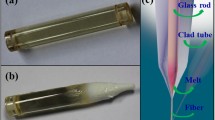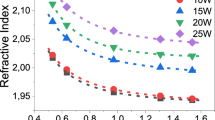Abstract
We present results on the lasing properties of the Bi-doped high-germania glass fibers thermally treated at different heating and cooling conditions. The absorption and luminescence spectra, the luminescence lifetime of bismuth-related active centers (BACs) formed in the Bi-doped fibers before and after treatment were measured. Analyzing the results, it was shown that the concentration of the BACs could be increased by approximately two times after treatment at certain conditions. A series of experiments regarding laser action at 1730 nm using pristine and treated Bi-doped fibers was performed. From the dependencies of the slope efficiencies of the Bi-doped fiber lasers on the length of the active fibers obtained at various cooling conditions, it was found that the optimal length \({L}\approx 20\) m of the treated active fibers required for the realization of the Bi-doped fiber lasers is two times shorter than that of the pristine fibers. In addition, the efficiency of the developed lasers being \(\approx 18\, \%\) with respect to the absorbed pump power is greater than that of the lasers based on the pristine fibers (\(\approx 10\%\) at \({L} = 20\) m), but it is lower than their maximum efficiency (\(\approx 25 \,\%\) at the optimum lengths of 45 m). From the numerical simulation of the Bi-doped fiber laser, a number of parameters needed for estimation of the native and thermally induced BAC concentrations were determined.









Similar content being viewed by others
References
K. Murata, Y. Fujimoto, T. Kanabe, H. Fujita, M. Nakatsuka, Bi-doped GeO\(_{2}\) as a new laser material for an intense laser. Fusion Eng. Des. 44(1), 437–439 (1999)
I.A. Bufetov, M.A. Melkumov, S.V. Firstov, K.E. Riumkin, A.V. Shubin, V.F. Khopin, A.N. Guryanov, E.M. Dianov, Bi-doped optical fibers and fiber lasers. IEEE J. Sel. Top. Quantum Electron. 20(5), 111–125 (2014)
N.K. Thipparapu, Y. Wang, S. Wang, A.A. Umnikov, P. Barua, J.K. Sahu, Bi-doped fiber amplifiers and lasers. Opt. Mater. Express 9, 2446–2465 (2019)
S.V. Firstov, S.V. Alyshev, K.E. Riumkin, A.M. Khegai, A.V. Kharakhordin, M.A. Melkumov, E.M. Dianov, Laser-active fibers doped with bismuth for a wavelength region of 1.6–1.8 \(\mu \text{ m }\). IEEE J. Sel. Top. Quantum Electron. 24(5), 1–15 (2018)
S.V. Firstov, V.F. Khopin, I.A. Bufetov, E.G. Firstova, A.N. Guryanov, E.M. Dianov, Combined excitation-emission spectroscopy of bismuth active centers in optical fibers. Opt. Express 19, 19551–19561 (2011)
E.G. Firstova, I.A. Bufetov, V.F. Khopin, V.V. Velmiskin, S.V. Firstov, G.A. Bufetova, K.N. Nishchev, A.N. Guryanov, E.M. Dianov, Luminescence properties of IR-emitting bismuth centres in SiO\(_{2}\)-based glasses in the UV to near-IR spectral region. Quantum Electron. 45, 59–65 (2015)
S. Firstov, A. Kharakhordin, S. Alyshev, K. Riumkin, E. Firstova, M. Melkumov, V. Khopin, A. Guryanov, E. Dianov, Formation of laser-active centers in bismuth-doped high-germania silica fibers by thermal treatment. Opt. Express 26, 12363–12371 (2018)
S.V. Firstov, S.V. Alyshev, V.F. Khopin, A.V. Kharakhordin, A.S. Lobanov, E.G. Firstova, K.E. Riumkin, A.M. Khegai, M.A. Melkumov, A.N. Guryanov, E.M. Dianov, Effect of heat treatment parameters on the optical properties of bismuth-doped GeO\(_2\):SiO\(_2\) glass fibers. Opt. Mater. Express 9, 2165–2174 (2019)
A. Kharakhordin, S. Alyshev, E. Firstova, A. Khegai, M. Melkumov, V. Khopin, A. Lobanov, A. Guryanov, S. Firstov, Analysis of thermally activated processes in bismuth-doped GeO\(_2\)-SiO\(_2\) glass fibers using the demarcation energy concept. Opt. Mater. Express 9, 4239–4246 (2019)
S. Wei, Y. Luo, D. Fan, G. Xiao, Y. Chu, B. Zhang, Y. Tian, M. Talal, M. Lancry, G.-D. Peng, BAC activation by thermal quenching in bismuth/erbium codoped fiber. Opt. Lett. 44, 1872–1875 (2019)
Q. Zhao, Y. Luo, Q. Hao, G.-D. Peng, Effect of thermal treatment parameters on the spectral characteristics of BAC-Al in bismuth/erbium-codoped aluminosilicate fibers. Opt. Lett. 44, 4594–4597 (2019)
S. Firstov, E. Firstova, S. Alyshev, V. Khopin, K. Riumkin, M. Melkumov, A. Guryanov, E. Dianov, Recovery of IR luminescence in photobleached bismuth-doped fibers by thermal annealing. Laser Phys. 26(8), 084007 (2016)
A.F. van Driel, I.S. Nikolaev, P. Vergeer, P. Lodahl, D. Vanmaekelbergh, W.L. Vos, Statistical analysis of time-resolved emission from ensembles of semiconductor quantum dots: Interpretation of exponential decay models. Phys. Rev. B 75, 035329 (2007)
J. Lakwicz, Principles of fluorescence spectroscopy (Springer, Boston, 2006)
E. Desurvire, Erbium-doped fiber amplifiers : principles and applications (Wiley, New York, 1994). “A Wiley-Interscience publication.”
Y. Hosono, H. Abe, D.L. Kinser, R.A. Weeks, K. Muta, H. Kawazoe, Nature and origin of the 5-eV band in \({SiO}_{2}\):\({GeO}_{2}\) glasses. Phys. Rev. B 46, 11445–11451 (1992)
S. Wei, Y. Luo, M. Ding, F. Cai, G. Xiao, D. Fan, Q. Zhao, G. Peng, Thermal effect on attenuation and luminescence of Bi/Er co-doped fiber. IEEE Photonics Technol. Lett. 29, 43–46 (2017)
Acknowledgements
The authors are grateful to A. N. Abramov and N. N. Vechkanov from Institute of Chemistry of High-Purity Substances of RAS for assistance in the fabrication of bismuth-doped fibers. This work was supported by Russian Science Foundation (grant 19-72-10003) (fiber fabrication and investigation of their properties); Russian Foundation for Basic Research (grant 18-32-20003) (lasing experiments using treated fibers).
Author information
Authors and Affiliations
Corresponding author
Additional information
Publisher's Note
Springer Nature remains neutral with regard to jurisdictional claims in published maps and institutional affiliations.
Rights and permissions
About this article
Cite this article
Kharakhordin, A.V., Alyshev, S.V., Firstova, E.G. et al. Lasing properties of thermally treated \(\hbox {GeO}_{2}\)–\(\hbox {SiO}_{2}\) glass fibers doped with bismuth. Appl. Phys. B 126, 87 (2020). https://doi.org/10.1007/s00340-020-07436-1
Received:
Accepted:
Published:
DOI: https://doi.org/10.1007/s00340-020-07436-1




